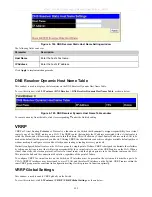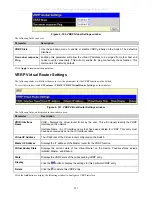
xStack
®
DGS-3600 Series Layer 3 Managed Gigabit Ethernet Switch
Figure 4- 119. IGMP Check Subscriber Source Network Settings (Edit) window
DVMRP Interface Configuration
The Distance Vector Multicast Routing Protocol (DVMRP) is a hop-based method of building multicast delivery trees from
multicast sources to all nodes of a network. Because the delivery trees are ‘pruned’ and ‘shortest path’, DVMRP is relatively
efficient. Because multicast group membership information is forwarded by a distance-vector algorithm, propagation is slow.
DVMRP is optimized for high delay (high latency) relatively low bandwidth networks, and can be considered as a ‘best-effort’
multicasting protocol.
DVMRP resembles the Routing Information Protocol (RIP), but is extended for multicast delivery. DVMRP builds a routing table
to calculate ‘shortest paths’ back to the source of a multicast message, but defines a ‘route cost’ (similar to the hop count in RIP)
as a relative number that represents the real cost of using this route in the construction of a multicast delivery tree to be ‘pruned’ -
once the delivery tree has been established.
When a sender initiates a multicast, DVMRP initially assumes that all users on the network will want to receive the multicast
message. When an adjacent router receives the message, it checks its routing table to determine the interface that gives the shortest
path (lowest cost) back to the source. If the multicast was received over the shortest path, then the adjacent router enters the
information into its tables and forwards the message. If the message is not received on the shortest path back to the source, the
message is dropped.
Route cost is a relative number that is used by DVMRP to calculate which branches of a multicast delivery tree should be
‘pruned’. The ‘cost’ is relative to other costs assigned to other DVMRP routes throughout the network.
The higher the route cost, the lower the probability that the current route will be chosen to be an active branch of the multicast
delivery tree (not ‘pruned’) - if there is an alternative route.
DVMRP Global Settings
This window is used to enable DVMRP globally on the Switch.
To view this window, click
L3 Features > IP Multicast Routing Protocol > DVMRP Global Settings
, as shown below:
Figure 4- 120. DVMRP Global Settings window
Use the pull-down menu, choose
Enabled
, and click
Apply
to implement the DVMRP function on the Switch.
263
















































